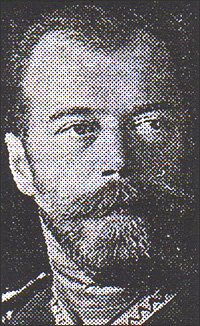|
SEARCHING FOR ANSWERS FOR ANSWERS IN THE GRAVE
OF THE TSAR
By MICK LaSALLE (Chronicle Staff Critic)
San
Francisco Chronicle, April 5, 1997

Tsar Nicholas
II
|
On
July 16, 1918, Russian Tsar Nicholas II and his family, under
house arrest by the Bolsheviks, were told to assemble for a group
picture. They huddled together in the basement and then the Bolsheviks
whipped out handguns and shot them all dead.
It was a cold-blooded, messy, protracted murder. It was also one
heck of a kick-off to 73 years of Soviet rule. For anyone deluded
enough to believe the Bolsheviks were great guys, this mass murder
was a big, fat clue. No wonder the Soviets suppressed information
surrounding it ---Soviet Communism’s original sin --- for
decades.
But now, the Communists are out of power, the forensic scientists
are snooping around, and there’s a new documentary at the
Roxie, “Mystery of the Last Tsar.” The film attempts
to nail down answers to some of history’s unanswered questions
about these murders and their aftermaths.
It can’t answer them completely. All the principal players
of 1918 are long dead, and the available evidence surrounding
some key points is too scanty to be conclusive.
But the film does bring to light a handful of previously unknown
facts, and it succeeds in making history breathe.
Without overplaying it, director Victoria Lewis uses actors to
re-create real events. She also has the good fortune to find her
own Shelby Foote in Russian playwright Edvard Radzinsky. Radzinsky,
who has researched the death of the imperial family for 25 years,
smiles gently at the camera and gives us history in personal terms.
|
Radzinsky assesses Nicholas II as a kind of Russian Jimmy Carter: “He
was a very good man and a very bad tsar.” He presents macabre
details --- for example, when the Bolsheviks started shooting, the bullets
bounced off the women. The killers, at first, thought it was a miracle.
In fact, the victims had jewelry concealed underneath their clothing.
(Some 18 pounds of it was recovered from the bodies.) Radzinsky’s
research also revealed that the execution order came from Lenin.
The
documentary --- not to confused with the TV documentary “Last
Days of the Last Tsar” --- tells the story of how the royal family’s
mass grave was discovered by a former KGB agent in 1979 who was forced
by his superiors to keep quiet. Only after the fall of Communism in
1991 were the bodies dug up and scientists brought in.
Eleven people were killed in the basement --- the Tsar, the Tsarina,
their son, four daughters and four servants. But only nine bodies were
recovered. “Mystery of the Last Tsar” speculates that two
of the children, including the legendary Anastasia, may have gotten
away. Interesting theories are presented, but little proof is offered.
Near the end of this satisfying documentary, the film takes a peculiar
but amusing detour, showing a London meeting of the Russian royal family’s
descendents. They seem like a squabbling pack of self-important losers,
making the Bolsheviks’ butchery seem slightly more understandable,
if unjustified.
<
BACK

|
